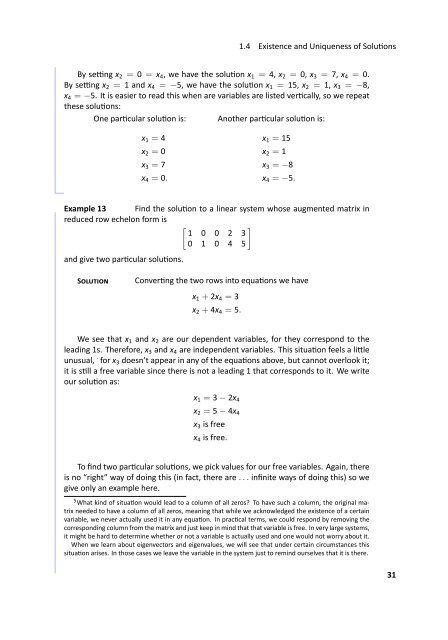Fundamentals of Matrix Algebra, 2011a
Fundamentals of Matrix Algebra, 2011a
Fundamentals of Matrix Algebra, 2011a
You also want an ePaper? Increase the reach of your titles
YUMPU automatically turns print PDFs into web optimized ePapers that Google loves.
1.4 Existence and Uniqueness <strong>of</strong> Soluons<br />
By seng x 2 = 0 = x 4 , we have the soluon x 1 = 4, x 2 = 0, x 3 = 7, x 4 = 0.<br />
By seng x 2 = 1 and x 4 = −5, we have the soluon x 1 = 15, x 2 = 1, x 3 = −8,<br />
x 4 = −5. It is easier to read this when are variables are listed vercally, so we repeat<br />
these soluons:<br />
One parcular soluon is: Another parcular soluon is:<br />
.<br />
x 1 = 4<br />
x 2 = 0<br />
x 3 = 7<br />
x 4 = 0.<br />
x 1 = 15<br />
x 2 = 1<br />
x 3 = −8<br />
x 4 = −5.<br />
. Example 13 .Find the soluon to a linear system whose augmented matrix in<br />
reduced row echelon form is<br />
[ ]<br />
1 0 0 2 3<br />
0 1 0 4 5<br />
and give two parcular soluons.<br />
S<br />
Converng the two rows into equaons we have<br />
x 1 + 2x 4 = 3<br />
x 2 + 4x 4 = 5.<br />
We see that x 1 and x 2 are our dependent variables, for they correspond to the<br />
leading 1s. Therefore, x 3 and x 4 are independent variables. This situaon feels a lile<br />
unusual, 5 for x 3 doesn’t appear in any <strong>of</strong> the equaons above, but cannot overlook it;<br />
it is sll a free variable since there is not a leading 1 that corresponds to it. We write<br />
our soluon as:<br />
x 1 = 3 − 2x 4<br />
x 2 = 5 − 4x 4<br />
x 3 is free<br />
x 4 is free.<br />
To find two parcular soluons, we pick values for our free variables. Again, there<br />
is no “right” way <strong>of</strong> doing this (in fact, there are . . . infinite ways <strong>of</strong> doing this) so we<br />
give only an example here.<br />
5 What kind <strong>of</strong> situaon would lead to a column <strong>of</strong> all zeros? To have such a column, the original matrix<br />
needed to have a column <strong>of</strong> all zeros, meaning that while we acknowledged the existence <strong>of</strong> a certain<br />
variable, we never actually used it in any equaon. In praccal terms, we could respond by removing the<br />
corresponding column from the matrix and just keep in mind that that variable is free. In very large systems,<br />
it might be hard to determine whether or not a variable is actually used and one would not worry about it.<br />
When we learn about eigenvectors and eigenvalues, we will see that under certain circumstances this<br />
situaon arises. In those cases we leave the variable in the system just to remind ourselves that it is there.<br />
31

















